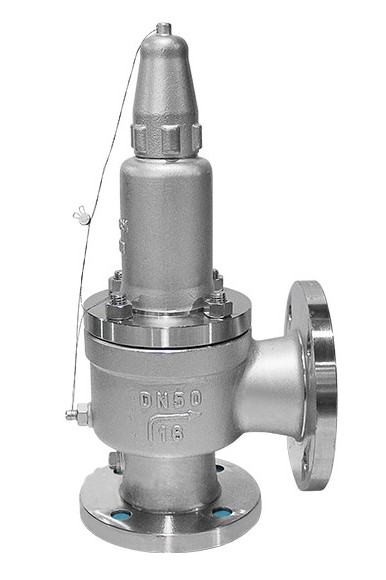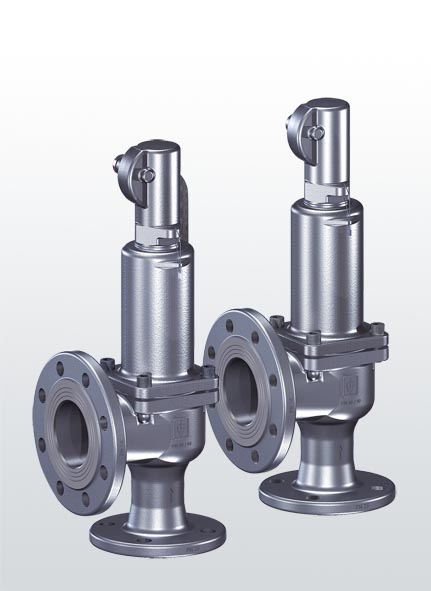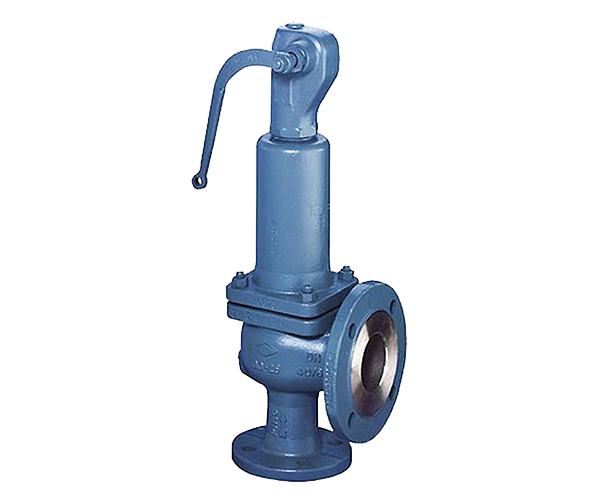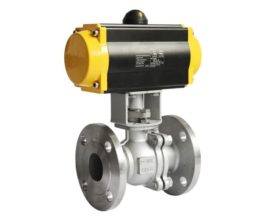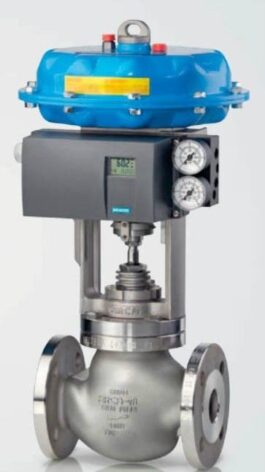Description
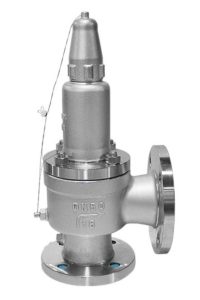
A Relief Valve or Pressure Relief Valves (PRV) is a type of safety valve used to control or limit the pressure in a system. Otherwise, the pressure might build up and create a process upset, instrument or equipment failure, or fire.
The pressure is relieved by allowing the pressurized fluid to flow from an auxiliary passage out of the system.
The relief valve is designed or set to open at a predetermined set pressure to protect pressure vessels. it is also designed to protect other equipment from being subjected to pressures that exceed their design limits.
When the set pressure is exceeded, the relief valve becomes the “path of least resistance” as the valve is forced open and a portion of the fluid is diverted through the auxiliary route.
The diverted fluid (liquid, gas or liquid–gas mixture) is usually routed through a piping system known as a flare header or relief header to a central, elevated gas flare. From that point it is where it is usually burned, and the resulting combustion gases are released to the atmosphere. As the fluid is diverted, the pressure inside the vessel will stop rising.
Once it reaches the valve’s reseating pressure, the valve will close. The blowdown is usually stated as a percentage of set pressure and refers to how much the pressure needs to drop before the valve re-seats. The blowdown can vary from roughly 2–20%, and some valves have adjustable blowdowns.
A pressure relief valve (PRV) is an essential component in various industries, including oil and gas, chemical processing, and manufacturing. Its primary function is to protect equipment and systems from overpressure, ensuring the safety and integrity of the entire operation.
Design of Pressure Relief Valves
A PRV is designed to release excess pressure by opening and allowing a controlled amount of fluid or gas to escape. This action helps maintain the pressure within safe limits and prevents potential catastrophic failures. The valve is usually set to open at a specific pressure level, known as the setpoint, which is determined based on the system’s design and operating parameters.
The construction of a PRV typically consists of a valve body, valve seat, and a spring-loaded disc or a pressure-actuated piston. The valve body is made of durable materials such as stainless steel or carbon steel to withstand high-pressure environments. The valve seat provides a sealing surface to prevent fluid or gas leakage when the valve is closed. The disc or piston is held in place by a spring or is directly actuated by the pressure exerted on it.
There are several types of PRVs available, including direct spring-loaded PRVs, pilot operated PRVs, and safety valves. Direct spring-loaded PRVs are the most common and simplest type, consisting of a spring that exerts a force on the valve disc or piston. When the force exerted by the fluid or gas pressure exceeds the spring force, the valve opens, allowing pressure to be released.
Pilot Valves
Pilot-operated PRVs use a combination of a pilot valve and a main valve to control the flow of fluid or gas. The pilot valve senses the pressure upstream of the main valve and sends a signal to open or close the main valve based on the setpoint. This design offers higher accuracy and can handle larger pressure differentials compared to direct spring-loaded PRVs.
Safety Valves
Safety valves are specifically designed for applications where a PRV failure could have severe consequences. These valves are usually made of robust materials and incorporate additional safety features, such as a secondary valve or a rupture disc that activates in case of a main valve failure.
Maintenance
The performance of a PRV is crucial for optimal operation, and regular maintenance and testing are essential. Manufacturers often provide guidelines for maintenance intervals, including inspection, cleaning, and calibration. Additionally, PRVs should be periodically tested to ensure that they open and close properly at the setpoint pressure.
In conclusion, a pressure relief valve is a critical component used to protect equipment, systems, and personnel from over pressurization. It functions by opening and releasing excess pressure, maintaining safe operating conditions. Different types of PRVs are available, each suited to specific applications and operating conditions. Regular maintenance and testing are necessary to ensure the reliability and performance of PRVs.
High Pressure Relief Valves
In high-pressure systems, it is recommended that the outlet of the relief valve is in the open air. In systems where the outlet is connected to piping, the opening of a relief valve will give a pressure build up. The Pressure Relief Valves will also be in the piping system downstream of the relief valve.
This often means that the relief valve will not re-seat once the set pressure is reached. For these systems often so called “differential” relief valves are used.
This means that the Pressure Relief Valves is only working on an area that is much smaller than the openings area of the valve. If the valve is opened the pressure has to decrease enormously before the valve closes. Also, the outlet pressure of the valve can easily keep the valve open.
Piping System
Another consideration is that if other relief valves are connected to the outlet pipe system, they may open as the pressure in exhaust pipe system increases. This may cause undesired operation.
In some cases, a so-called bypass valve acts as a relief valve by being used to return all or part of the fluid discharged by a pump back to either a storage reservoir or the inlet of the pump or gas compressor.
This is done to protect the pump or gas compressor and any associated equipment from excessive pressure. The bypass valve and bypass path can be internal (an integral part of the pump or compressor) or external (installed as a component in the fluid path).
Operating Pressures
Furthermore, the installation of a pressure relief valve requires careful consideration of certain factors. One crucial aspect is the determination of the setpoint pressure. This pressure level should be calculated based on the system’s maximum allowable working pressure (MAWP) and the desired safety margin. Properly setting the setpoint ensures that the valve opens at the appropriate pressure to prevent damage to the equipment or system.
Another important consideration is the sizing of the pressure relief valve. The valve must be adequately sized to handle the maximum anticipated flow rate during an overpressure event. Improper sizing can result in inadequate pressure relief or excessive pressure drop, compromising the system’s performance and safety.
It is also essential to select the appropriate pressure relief valve in terms of its materials of construction. The valve’s materials should be compatible with the fluid or gas being handled, as well as the operating temperature and pressure conditions. This helps prevent corrosion, wear, or degradation of the valve, ensuring its long-term reliability.
Industry Standards
Moreover, pressure relief valves often need to comply with industry standards and regulations. Organizations, such as the American Society of Mechanical Engineers (ASME) and the International Organization for Standardization (ISO), provide guidelines. they also provide codes for the design, installation, and maintenance of pressure relief systems. Adhering to these standards ensures that the PRV meets the necessary safety requirements.
Additionally, advancements in technology have led to the development of intelligent pressure relief valves. These valves incorporate sensors, actuators, and monitoring systems that can provide real-time data about the valve’s performance. Intelligent PRVs can offer enhanced control, diagnostics, and predictive maintenance capabilities, contributing to the overall operational efficiency and safety of the system.
Technology for Pressure Relief Valves
In recent years, rapid advancements have been made in the field of valve technology, including the development of smart valves and predictive analytics.
Advantages of Pressure Relief Valves
Safety assurance
The primary advantage of pressure relief valves is that they provide a crucial safety measure in industrial processes. They prevent equipment and systems from experiencing dangerous levels of pressure, thus avoiding catastrophic failures, explosions, or other accidents.
Equipment protection
Pressure relief valves help protect valuable equipment and machinery from damage caused by excessive pressure. By releasing the excess pressure, they prevent damage to pipes, vessels, and other components. This will be prolonging their lifespan and reducing the likelihood of costly repairs or replacements.
Compliance with regulations
Pressure relief valves often need to comply with industry standards and regulations. This is needed to ensure the safety of workers and the environment. In Addition, by using PRVs that meet these standards, companies can demonstrate their adherence to safety guidelines. This will help with avoiding potential legal and regulatory issues.
Flexibility in applications
Pressure relief valves are versatile and can be used in various industries and applications. Whether it’s in the oil and gas sector, chemical processing, power generation, or manufacturing, PRVs can be tailored to meet the specific requirements of different processes.
Reliability
When properly maintained and tested, pressure relief valves offer reliable and consistent performance. Regular inspections and maintenance ensure that the valves are in optimal working condition. Moreover, providing peace of mind and minimizing the risk of failure.
Disadvantages of Pressure Relief Valves
Pressure fluctuations
In some cases, pressure relief valves may cause pressure fluctuations within a system. When the valve opens to relieve excess pressure, it can lead to a temporary drop in system pressure. While this drop may be necessary to prevent overpressure, it can impact the stability and performance of downstream processes.
Potential leakage
Pressure relief valves, like any mechanical device, are susceptible to wear and degradation over time. This wear can lead to potential leakage around the valve seat or other sealing areas. Regular inspection and maintenance can help mitigate this risk, but it remains a potential disadvantage.
Limited control over discharge
While pressure relief valves are essential for preventing overpressure, they do not offer precise control over the discharge of fluid or gas. Once the valve reaches its setpoint, it opens fully, releasing the excess pressure. In some cases, this release of material can be undesirable or lead to losses.
Performance limitations
Pressure relief valves have specific performance limitations, including their ability to handle high flow rates or pressure differentials. Depending on the application, special considerations may be required. This will ensure optimal performance and prevent issues such as chattering or excessive noise.
It is important to note that these advantages and disadvantages can vary depending on the specific design, type, and maintenance of the pressure relief valve used. Additionally, advances in technology and smart valve systems are continually addressing some of these disadvantages, offering improved control, monitoring, and reliability.
In conclusion, pressure relief valves play a vital role in ensuring the safety and reliability of various industrial processes. They provide an essential safeguard against overpressure, preventing potentially hazardous situations. By selecting the appropriate PRV, following proper installation guidelines, conducting regular maintenance. Also, staying updated with industry standards, organizations can effectively protect their equipment, systems, and personnel from the risks associated with excessive pressure.
If this is not the type of valve you need, pls visit Valves

